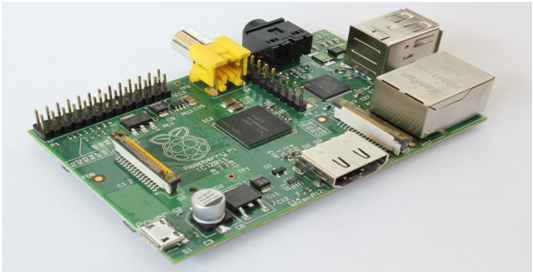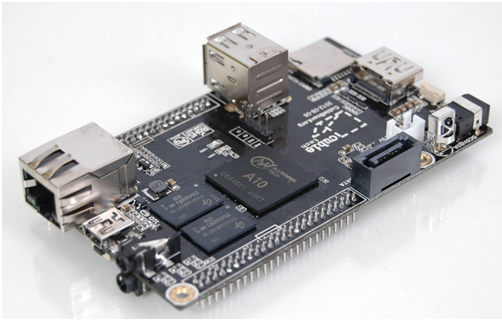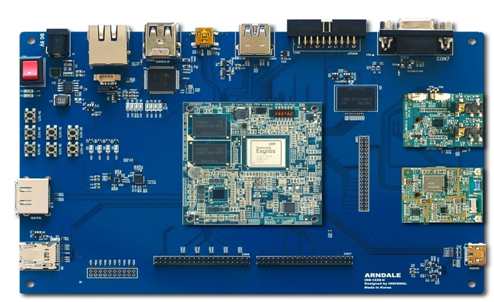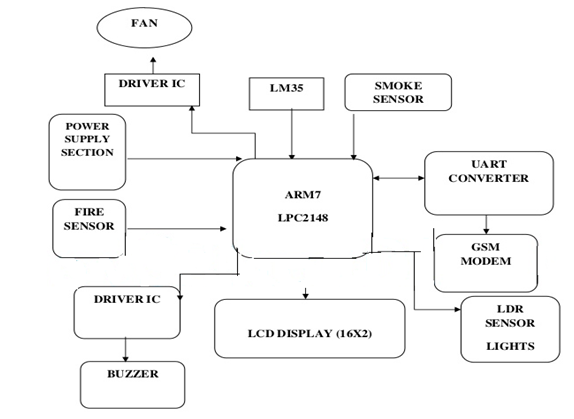The ARM family is the most advanced
family of microcontrollers. Nowadays so many applications are developed
based on ARM controllers and processors. The ARM stands for Advance Risk
Machine. Currently many controllers and processors families are
available like 8051, AVR, PIC, Motorola, etc, but still the ARM is very
popular and is chosen for many applications and domains. There are many
reasons for their in embedded based applications, such as their device
functionality, set of peripherals and high speed data processing.
The ARM manufactures each add their own
mixture of peripherals and add on functionality to the chip. Many chips
with ARM family include a A/D converters, counters/timers, capacitive
touch controller, LCD controller, USB, Wi-Fi base band etc; there are
already built into the chip. This saves on port cost, design time and
physical space on the circuit board. Most of the companies prefer to use
ARM families over and over again. The ARM9 and ARM7 are the most
popular in ARM families.
 ARM9 Development Board:
ARM9 Development Board:
The ARM9 is a high performance ARM
controller/processor. It has a high efficiency, dual issue sub scalar
and a dynamic length pipe line (8-11 stage). It has light weight
workload as well as peak performance. The ARM9 performance is better
than ARM7. It is currently used in smart phones and digital TV, consumer
electronics and enterprise applications.
ARM9 Development Board Features:
- 32 bit RISC Architecture
- SD-RAM -128M-Byte
- SRAM 256K-Bytes
- Flash memory 64m-Byte
- One-Channel-UART(9 pin port)
- One Host type USB port & selectable devices.
- One JTAG port for program downloading
- RTC input logic
- ADC interface expansion port
- SPI interface
- AC97 interface for audio input and output
- Ethernet interface
- 4EA input output expansion port
- 4-Bit LED display
- CCD camera interface port
- Zigbee network board expansion port available
- Speaker built-in.
ARM11 Development Board:
The ARM1 is a high performance ARM
controller/processor with 256Mbytes DDR RAM and 1 GB flash, RTC and
audio and Ethernet on board. It has integrated RS232, USB, keyboard,
LCD, camera, SD cord and other functions on board. The board supports
the Linux, Android and windows operating system and which provides a
complete basic drivers. This would be an ideal development platform for
multimedia and communication applications.
ARM11 Development Board Features:
- The RAM memory is 256Mbytes
- 1 GB NAND flash memory
- EEPROM 1024 bytes
- SD cord socket for external memory
- Four serial ports connectors (UART)
- Infrared receiver
- USB port, Ethernet
- Real time clock with battery (RTC)
- PWM buzzer, 20 pin camera interface
- LCD interface
- 4-wire resistive touch panel
- 8-push buttons for user input and A/D converter-1
- SPI, I2C protocols and 40 pin system bus
- One JTAG port for program downloading
Cortex Development Board:
It is a new exciting and high
performance development board. This board is packed with new features
and high performance. The cortex microcontroller has total of 16 channel
A/D converter and standard interfacing protocols which includes I2C,
SPI, USB and 2- UART channels. The board also includes real time clock
and battery backup. The JTAG connector is included for easy program
testing and debugging purpose. It is a most demanding high performance
application and can be used in a wide range of embedded solutions.
Cortex Development Board Features:
- 32 bit RISC Architecture
- 128KB of flash memory
- 20KB of RAM memory
- Real time clock and battery backup
- 16-channel ADC and 12 bit accuracy
- Four general purpose 16-bit timers
- 2-UARTs and 2-I2C communication 3-SPI and 1-CAN and 1-USB communication
- One LCD connection with contract adjustment
- One JTGA connection for programming and debugging
- 8-red test LEDs
- Crystal frequency 8.000MHz and speed up to 72MHz
- SD cord socket
- Power on LED, Reset Button
- Power supply 5v Dc
STM32 Development Board:
The STM32 is a family of
microcontrollers developed, based on ARM cortex series microprocessors.
It is a most recent and high performance development board. It offers 32
bit product range that combines high performance, real time
capabilities, digital signal processing, low voltage operation, while
maintaining full integration ease of development. STM32 developed by
STMicroelectronics and ST attach their own peripherals to the core. The
STM32 board has USB-OTG FS, CAN, USART channels. It has integrated
Ethernet, Micro SD cord, smart cord, Audio DAC and other functions on
board. The motor control pins are used to easy to control the motor.
STM32 Development Board Features:
- 512 Mb flash memory and 64Kb of RAM memory
- Operating voltage is 2-3.6v
- Operating frequency 72 MHz
- Communication interfaces 3- SPI, 5-USART, 2-I2C, 1-FSMC,1-USB,1-CAN,1-LCD,1-SDIO
- 32-bit RISC Architecture
- 8M crystal oscillator
- Three 12 bit A/D converters and 2-12bit D/A converters
- It support JTAG/SWD interface, supports IAP.
- Connect the SD board easily , it is much faster to read/write the micro SD cord via SDIO pins using SPI
- Using 8 i/o interface to easily connect the keypad, motor
- Internal RTC
- NAND flash interface
- PS/2 interface
- One wire interface
- 5v DC jack
- SD cord socket
- Boot mode selection pins
- VBAT selection Jumper
- Temperature sensor
- Solar sells
Applications:
- Main stream smart phones
- Tablets and set top boxes
- Home media player
- Residential Gateway
Differences between ARM Family and Other Families (like 8051, PIC, AVR):
- The ARM executes all instruction in only one cycle and other family controllers takes more than one cycle.
- The ARM has load store architecture i.e. data processing instructions can not access memory directly; data has to be stored in a register before processing. Other families can access memory directly.
- In ARM families all peripherals are in built in a chip
ARM Based Industrial Automation Using GSM:
This application is very helpful for the
industries. For any application in the industries there are many
parameters to be handled. This application is used to save the power and
major components in the industry based on sensors. The temperature
sensor is fixed at a specified location, for our application to be
performed. The sensor gets the values and sends the information to the
microcontroller continuously. The microcontroller receives the values
and sends the corresponding values to LCD display.
Whenever the temperature exceeds the set
point the controller drives the fan ON and if the set point decline its
drives the fan OFF. Whenever the smoke exceeds the set point the
controller drives the BUZZER ON and if the set point declines its drives
the BUZZER OFF. Whenever the light exceeds the set point the controller
drives the light ON if the set point decreases its drives the light
OFF. The GSM modem is connected to the microcontroller through MAX 232.
GSM modem first makes a call and then sends the message. This
application is for industries with heavy parameters to handle. Now a day
these are used in all kinds of industries and commercial complexes.
Following are the List of Some of the ARM Based Projects:
- ARM Based Mine Detection Robot Using GPS Technology
- ARM Based Hospital Enquiry System
- ARM Based Digital Notice Board Using GSM
- ARM Based Home/ Industrial Automation Using GSM
- Automatic Touch Screen Based Vehicle Driving System Using ARM
- Secured Communication Between Two Army Stations Using ARM7
- Wireless Biomedical Parameter Monitoring System Using ARM9
- Postpaid and Prepaid Energy Meter Using ARM
- Temperature and Humidity Control System Using ARM and Graphical LCD
- ARM Based Remote Temperature Controller With Ethernet
- ARM Based Smart Power Generation and Multi Purpose Operation
- ARM and RFID Based Security System (Home , Office, Industrial)
- Multi Functional Car With Accident Alert Sensors Using ARM
- Voice Based GPS Navigation System Using ARM
- Mobile Operated Water Robot Using ARM
- ARM Based Wireless Whether Monitoring System
- Touch Screen Based Crane Control System Using Cortx-M3
- Biometrics Based Security System With Face Detection Using ARM
- Wireless Finger Print System School and Office Using ARM
- ARM Based Vehicle Tracking System Using GPS and GSM
- ARM Based Reorganization Technique for ATM Using IRIF Technology
- ARM Based Wireless Patient Monitoring system
- ARM Based Smart Shopping System
- ARM Base Automated Bus Arrival Announcement System for the Blind Persons.
- ARM Based Automated Cleaning Robot
- ARM Based Wireless Smart Toll Collection System
- Development of remote waste gas system using ARM7
- Advanced Electronic Voting Machine using ARM
- Exploiting Bluetooth on for Home Security Application using ARM9
- Bluetooth based device ON/OFF control Using ARM
- CAN based collision avoidance system for Automobiles
- CAN Protocol Based Autonomous Robot Controlling System Using Cortex
- Biometric fingerprint Identification based Bank Locker Security System Using ARM












No comments:
Post a Comment